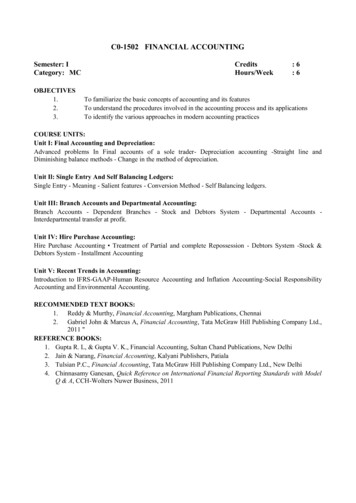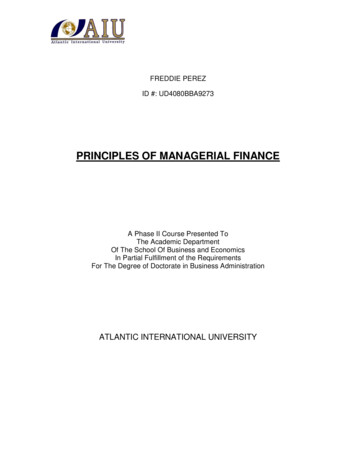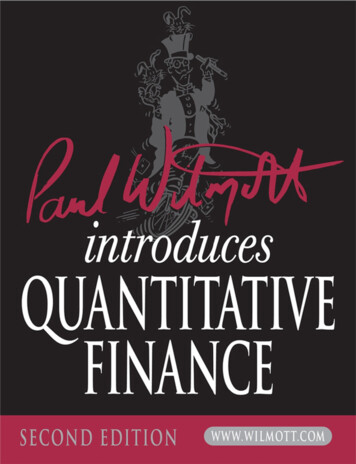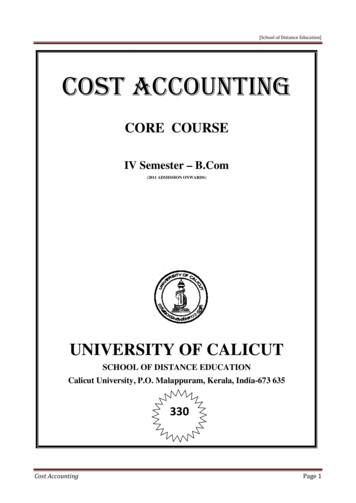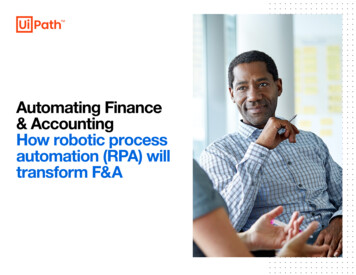
Transcription
Automating Finance& AccountingHow robotic processautomation (RPA) willtransform F&A
CONTENTSContentsUIPAT H.CO M AUTO MATION F I RST ERASection 103IntroductionSection 204F & A: a changing function04The challenges of digital F&A transformation04The impact of F&A legacy systems05Extracting data is still very manual05Business process management: not the complete solution we hoped forSection 306Robotic Process Automation: lightweight, flexible automationSection 407Picking processes and peopleSection 508Finance and Accounting process automation entry points09Considerations for automation09The results of RPA can be dramatic10RPA: The onramp for artificial intelligence in the enterprise10Case in point: cash applicationsSection 611How UiPath RPA works11Make automation a priority2
SECTION 01 INTRODUCTIONIntroductionInnovation is the name of thegame for businesses trying tostay one step ahead of theircompetitors. Regardless ofthe type of business you run,accounting and finance is acritical source of operationalinnovation and competitivedifferentiation in sectors asdiverse as consumer electronicsand automotive manufacturing.Unfortunately, in manyorganizations, legacy processesare hindering the digitaltransformation of basicaccounting operations. RoboticProcess Automation can bea powerful on-ramp to thedigital transformation of theseprocesses.UIPAT H.CO M AUTO MATION F I RST ERAHaving spent over a decadedeveloping the technology,UiPath is a leading provider ofRPA software.In the pages below, we willbuild the argument for whybusinesses should rethink theway they currently executeprocesses and explore how therole of finance professionalsis changing, the challengeswith legacy systems and howRPA offers the opportunity forbusinesses to become leadersin digital transformation.3
SECTION 02 F&A: A CHANGING FUNCTIONF&A: a changing functionAs a result of the 2008 global financial crash, businesses across the world place a higher premium onfinancial health, starting with cost control and risk management. To improve the financial health of thebusiness, accounting departments have been under pressure to deliver greater performance againstbudgets. Greater scrutiny has been placed on all areas of accounting operations, reportingand management support.As a result, business modelsand accounting roles arechanging. Chief FinancialOfficers (CFOs) and theirrepresentatives increasinglydrive more informedstrategic decisions acrossbusiness disciplines. Financeprofessionals now also occupyseats at the highest levels ofthe organization where theyare expected to use theircommercial and technicalskills to advise seniorbusiness leaders.CFOs are now a crucial partnerin enabling the growth ofthe business, providing theappropriate financial data andinsights. They also ensure thatthe business complies withthe relevant regulations whilemitigating its risk exposure.However, as this strategicfocus has grown, finance andUIPAT H.CO M AUTO MATION F I RST ERAaccounting professionals havestruggled to meet the volumeand variety of the existingoperational transactions theirjob encompasses. In manycases, financial professionalswould rather be spending lesstime on routine accountingoperations and more on highervalue work that drives morestrategic outcomes.The challengesof digital F&AtransformationTo this end, there hasbeen an industry-wideshift to undertake digitaltransformation initiatives toimprove efficiency, minimizebusiness risk and improvetransparency within theorganization. However, thistransformation has comewith its own set of challengesincluding legacy systems,paper-based documents,unstructured formats,natural language interactionsand fragmentation. Thesechallenges must be addressedif an organization is to trulymake the most of digitaltechnologies in its accountingfunction.In many cases [ERP systems] forcecompanies to re-engineer their businessprocesses to accommodate the logic ofthe software modules for streamliningdata flow throughout the organization.The impact of F&Alegacy systemsThe introduction of enterpriseresource planning (ERP)software in the early 1990s seta precedent for multinationalbusinesses to fundamentallychange the way they interactwith accounting and financedata.“In many cases [ERP systems]force companies to re-engineertheir business processesto accommodate the logicof the software modulesfor streamlining data flowthroughout the organization,”(The Evolution of ERP Systems:A Historical Perspective.)As well as re-engineeringtheir processes, many largeorganizations have spentdecades investing heavilyin modules and add-ons tothese ERP systems, assigningmuch of their workforce tousing and maintaining them.Accounting processes havebeen engineered to fit aroundapplications such as Oracle E-Business Suite, SAP , Oracle JD Edwards EnterpriseOne,and Oracle PeopleSoftApplications.This has made largeorganizations sluggishin responding to digitaltransformation. In comparison,newer, born-in-the-cloudbusinesses have a much easierjourney because they don’trely on cumbersome legacyapplications, they were borndigital.4
SECTION 02 F&A: A CHANGING FUNCTIONExtracting data isstill very manualAnother challenge is that manyaccounting documents suchas invoices, purchase orders,expense statements, andeven checks, to name just afew, are still processed onphysical paper.They’re often scanned in asimages to create a digital copyand they’re then archivedin physical storage. Thiscompounds the problem; datafrom the scanned image is notelectronically readable unlessa specialized optical characterrecognition (OCR) software isemployed and, secondly, thephysical paper-copy still needsto be stored, adding an extracost to the process.Even once the data has beenextracted, it often takesthe form of unstructuredinformation or consists ofnatural language that isunderstood by humans butis not easily used by mostsoftware. Contracts andcustomer interactions thatare audio-recorded are agood example of this. NaturalUIPAT H.CO M AUTO MATION F I RST ERAlanguage needs to bereworked into a structuredformat that can be easilyprocessed by computersystems. Once it’s extractedand structured, the data stilloften needs to be manuallyrecorded into the system tobe processed digitally.reads it, verifies the approvalsand extracts the data, inputtingit directly into the accountingpackage — or for large firmsthat receive hundreds ofinvoices a day, this may beextracted into a spreadsheetfirst and then imported intoaccounting software.Business processmanagement:not the completesolution wehoped forOnce it’s in the accountingsoftware, the invoice is readyfor payment and processedfor payment disbursementbased on the payment termsand the frequency of paymentbatch runs. AP professionalsperform these payment runsmanually by batching up invoicesfor payments, checking andremoving duplicates and finallydisbursing either for physicalcheck prints or electronic fundstransfer (EFT) to banks.To date, many of the processmanagement methods thatbusinesses have used toovercome these challenges havenot been ideal. One methodthat businesses have tried inthe past is to create programsthat improve efficiency of someof the repetitive accountingprocesses that humans do.A typical Accounts Payable (AP)invoice processing workflowfor a human might be asfollows. First, they receive apaper invoice or an invoiceby e-mail, which is approvedmanually or over email, printedand then submitted to AP. AnAP clerk takes this invoice,Prior to robotic processautomation, IT programs andtheir processes revolved aroundmaking the process efficient andvisible through business processmanagement methods. Theystreamlined the flow, but at aheavy development cost, andeven then, it cannot be said tohave truly automated the process.This is where robotic processautomation (RPA) comes in.5
SECTION 03 ROBOTIC PROCESS AUTOMATION: LIGHTWEIGHT, FLEXIBLE AUTOMATIONRobotic Process Automation:lightweight, flexible automationThe institute for RoboticProcess Automation (IRPA)defines RPA as, “the applicationof technology that allowsemployees in a company toconfigure computer softwareor a ‘robot’ to capture andinterpret existing applicationsfor processing a transaction,manipulating data, triggeringresponses and communicatingwith other digital systems”.Rather than hard-codeautomation workflows andApplication ProgrammingInterfaces (APIs) into softwareprograms, RPA mimics aperson’s actions on top ofexisting systems. RPA worksin the same way that a humanworker reads and interpretsdata from a physical documentand transfers this to multipleapplications on their computer.Robots can seamlessly movedata across boundaries, fromone application to another,mimicking activities such asclicking, typing, and movingbetween windows. In addition,UIPAT H.CO M AUTO MATION F I RST ERAthese robots can use native andadd-on Artificial Intelligenceand Machine Learning modelsto enhance overall capabilityand learn from experience.For accountants and financeprofessionals, RPA can play acrucial role in transforming youroperations. Where, in the past,organizations have off-shoredmany of their transactionheavy accounting processes tolabor arbitrage regions such asIndia, South East Asia and theMiddle East, RPA can improveefficiency and effectiveness,without the increased risks,degraded customer experience,and increasingly vanishing lowlabor arbitrage benefits fromtraditional outsourcing or offshoring key business processes.Because digital labor in the formof RPA can supplement andaugment the human workforce,it allows people to achievemore with fewer resources inless time. Accounting firmsand service providers canbegin to move away from thetraditional approach of fulltime-equivalent (FTE) revenuemodels, where revenue isdetermined by individualtime-based productivity,towards outcome-basedrevenue models that considervalue-add versus traditionaltransactional metrics.The robots used in RPA aremuch more cost effective atprocessing large volumes ofrecurring tasks. The robots canwork around the clock withoutfatigue and, although there areinitial setup costs and ongoingmaintenance costs, the returnon investment (ROI) with RPA ismuch higher.outstanding (DSO) value.Robots free up your expensiveF&A resources to workon higher value activitiesand focus on outcomes,which not only improvesemployee engagement butcompetitiveness and customerexperience as well.Because digital labor in the form of RPAcan supplement and augment the humanworkforce, it allows people to achievemore with fewer resources in less time.However, for many accountingdepartments, ROI may not bethe only driving factor. Here,RPA also provides better riskmanagement and compliance,higher accuracy, bettercycle times and improvedthroughput. This is essentialfor end-of-month reportingand for accounts receivable,lowering the days sales6
SECTION 04 PICKING PROCESSES AND PEOPLEPicking Processes and PeopleWith the use of RPA, for the first time, accountingdepartments can reliably automate many of theprocesses they were previously unable to.The fitness criteria for choosingwhich processes to automate are:It must be a highly manual, repetitiveand high volume processIt must be a rule-based processIt must have a low exception rate(low variation between processes)The inputs must be electronic ormachine readableThe processes and their underlyingApplications must be stableUIPAT H.CO M AUTO MATION F I RST ERAOne of the key considerationsis variation. For example, if90% of your transactions canbe mapped in ten steps, but10% require an additionaltwo steps to be completedafter step three, this becomesan exception to the rule thatneeds to be managed. Here,exception paths need to bebuilt into the workflow tomanage the variation. Whilethese processes can alsobe automated, it will taketime to build workflowsinto the robotic process, sothe business has to make adecision as to whether theadditional time deliversvalue. This is where the roleof humans alongside RPAwill change. As robots takeover the routine, repetitivetransactional processingtasks, finance and accountingprofessionals will be expectedto become expert exceptionhandlers. They will needto perform the complex,judgement-based, transactionsthat the robots are not ableto perform.The role of managers inaccounting departmentsof the future will move awayfrom managing people todriving higher value activitiesfrom their staff, includingexceptions and decisions thatrequire human intervention,while the orchestrationengine oversees operationalperformance. Finance andAccounting professionalswill move away from datagathering, data entry andbook-keeping and insteadtake on more advisory roleswhere their judgement andconsultative skills will seethem become businesspartners.7
SECTION 05 FINANCE AND ACCOUNTING PROCESS AUTOMATION ENTRY POINTSFinance and Accountingprocess automation entry pointsHere, we’ve picked out a list of the processes in finance and accounting that are highly suited to RPA. Though the listing is notcomprehensive, it provides a good suggestion of F&A sub-processes that can be explored by any organization that is embarkinginto driving RPA-led digital transformation of its F&A function.Procureto PayAccountsReceivableGeneralaccountingTax, treasuryand complianceFinancial planning,analysis and reportingPurchase order entry and deliverySales order entryData aggregation for tax liabilityVendor verification and setupCustomer data set upGeneral ledger and subledgerreconciliationsCustomer data managementBank reconciliationsComplete tax return workbooksData aggregation for reportsReport preparation(including the below)Vendor queries/helpdeskBilling/invoicingInter-company reconciliationsPrepare tax returnsInvoice receipt and classificationCollection activities (dunning)Manual journal entriesFile tax returns and paymentsInvoice data extractionCash applicationReclassification journal entriesTax accounting entriesInvoice data entry and interfaceCredit risk managementTwo and three-way purchaseorder/invoice/Dispute verification andresolutionreceipt matchingChargeback managementVendor master-data managementConvert data to tax basisn Trial balance and balance sheetn Profit and lossn CashflowFixed asset accountingn Variance analysisInter-company settlementsn Management reportsFinancial close activitiesn Statutory/regulatory reportsNon-purchase-order invoicecodingVendor statement reconciliationAccounts payable accrualjournal entryExpense compliance auditPayment processingUIPAT H.CO M AUTO MATION F I RST ERA8
SECTION 05 FINANCE AND ACCOUNTING PROCESS AUTOMATION ENTRY POINTSConsiderations for automationA great place to start if you’reconsidering using RPA is to startby automating straightforwardprocesses such as invoice dataentry and cash applications.These are best suited to carryout proof-of-concept studiesbefore beginning your RPAjourney. You can follow thiswith other processes such asbilling and invoicing, as wellas customer and vendor dataset-ups.Moving on to generalaccounting processes, theseare often fragmented as a resultof being been generated fromperiodic and event-drivenactivities. Here, the best wayto automate general accountingprocesses is to take a more agileand iterative approach to realizethe most value from automatingthe process effectively.Another consideration tomake for general accountingactivities, such as manualjournal entries, is to useattended rather thanunattended automation asthese processes could requirethe need for expert judgementor a customized computationspecific to the event or scenario.The best way to automate generalaccounting processes is to take amore agile and iterative approach torealize the most value from automatingthe process effectively.UIPAT H.CO M AUTO MATION F I RST ERAThe results of RPA can be dramaticProcessClientPurchase order entryautomationGlobal automotivesupplier, Germany% of RobotizationBenefits100%8 months ROI100% accuracy rate78% improved processing timeCredit note processingMedia company,Switzerland100%3 months ROI100% reduction in manualeffort and accuracy60% improved processing timeTravel and expensereport processingConsumer goodscompany, Germany100%15% manual effort reduction75% improved processing time100% accuracyAccounts payable:Three-way matchingautomationMedical/pharmaceuticalcompany, Switzerland100%2 months ROI90% improved processing time10% manual effort reductionTravel and expensereport processingConsumer goodscompany, Germany100%15% manual effort reduction75% improved processing time100% accuracyGRN-to-Invoice matchand release holdBuilding materialssupplier, UK53%100% compliance on TAT SLA54% FTE reductionAutomate vendorpaymentsGlobal property insurerInvoicing/billingautomationHR service provider,Germany70%3 months ROI10% manual effort reduction75% faster processing60% cost reductionCash applicationRetail company, India100%100% accuracy80% volume automatedMonth-end accountingAccounting servicesprovider, Germany75%5 months ROI25% manual effort reduction65% improed processing time100% accuracyDaily P&L reportsgenerationGlobal financial servicescompany100%67% improved processing timeFaster/earlier report delivery100% reporting accuracy—70% productivity improvement50% operations cost reduction9
SECTION 05 FINANCE AND ACCOUNTING PROCESS AUTOMATION ENTRY POINTSRPA: the onramp forartificial intelligencein the enterprisecreated by closely monitoringemployee behavior to createrobots that can solve complexexceptions.RPA, artificial intelligence(AI), machine learning(ML) and other advancedcognitive technologies arecomplementary to oneanother. While pure RPA canperform rule-based repetitivetasks, this can be enhanced byembedding AI, ML andcognitive technologies.Case in point:cash applicationThis acts to not only futureproof RPA, but to be the onramp for AI into the enterprise.It often starts with AI computervision to allow easier, fasterand more stable automationfor virtualized environments.This is particularly useful forsituations where traditionalbusiness process managementmethods that use SAP, Flash,PDF and images etc. fail or aredifficult to use.Exception management isanother area of interest. UiPathis already using machinelearning to enable robots to selfrecover from simple exceptions.More advanced algorithms forexception management can beUIPAT H.CO M AUTO MATION F I RST ERACash applications are a goodexample to illustrate how RPAcan be complemented bycognitive and machine learningtechnologies.The inputs to a cash applicationtypically involve open or agingreceivables and paymentsreceived, which are importedinto suspense accounts frombank statements to be appliedand cleared.Other inputs into cashapplications include paymentremittance advice instructionsfrom customers in the form ofemail notifications, supportingdocuments attached tochecks as well as free-formmessages or notes within banktransactions.include extracting paymentinformation from images ofchecks, extracting and curatingremittance information fromemails and the supportingdocuments and banktransaction messages, as wellas matching the payments toopen receivables using theremittance information.In these situations, RPA is usedto process the open receivableusing information from theaccounting system, to fetchbank statements and feedthem into the accountingsystem, and to automate theprocess of matching paymentsto open invoices and thenclosing them.While many organizations usingSAP, Oracle or another modernERP have partially automatedthe cash application processusing native features of theseERPs and have achieved acertain degree of automation(typically around 40-50%),there are still a large amountof exceptions or fall-outs thatrequire human effort. This iswhere RPA, combined with AIand ML comes to the rescueto take the percentage ofautomation much further(to around 80-90%).Cognitive and machine learningtechnologies can carry out a varietyof actions including extracting paymentinformation from images of checksand extracting and curating remittanceinformation from emails.In these situations, cognitiveand machine learningtechnologies can carry outa variety of actions. These10
SECTION 06 HOW UIPATH RPA WORKSHow UiPath RPA worksUiPath has spent over a decade developing one of the world’s leadingRPA platforms. Our Enterprise RPA Platform consists of three products:UiPath Studio, UiPath Robot and UiPath Orchestrator.Studio is the designer tool usedto create diagrams of businessprocesses. Based on theMicrosoft Workflow Foundation,and visually similar to MicrosoftVisio, Studio is an advancedvisual process modeling tool.It allows users to drag-anddrop different elements in aprocess to design differenttypes of workflows, sequences,flowcharts and transactionalbusiness processes.Studio contains a built-in libraryof over 300 predefined actionssuch as clicking and typing thatallow it to interact with a varietyof desktop applications, webbrowsers and OCR engines.Studio is also designed to workwith all types of e-mail clientsincluding SMTP, IMAP and POP3Server-based ones such asGmail, Outlook and Exchange.The predefined activitiesare great at reading e-mails,downloading attachmentsand composing and sendingnew e-mails.UIPAT H.CO M AUTO MATION F I RST ERAThe great thing about Studio isthat users don’t need to knowany coding. They can simplyuse the record feature andcarry out a task and the tool willautomatically create a workflowthat can be amended visually.UiPath Robot runs theprocesses designed in Studioin the same way that a humanuser would. It can work eitherby assisting the human user,or completely autonomouslywithout supervision for virtualor remote environments.UiPath Orchestrator is a webbased platform that allowsusers to manage all the robotsthey’ve created, using theplatform to enable remotecontrol, monitoring, releasemanagement and centralizedscheduling of the robots.Make automationa priorityDigitalization is the firststep in preparing modernorganizations for the digitalworld, but once it becomesthe norm, gaining a truecompetitive edge will require alot more. By making automationa priority, accounting andfinance departments canposition themselves to leadthis transformation.Contact UsFollow us: Twitter LinkedIn11
software in the early 1990s set a precedent for multinational businesses to fundamentally change the way they interact with accounting and finance data. “In many cases [ERP systems] force companies to re-engineer their business processes to accommodate the logic of the software modules






